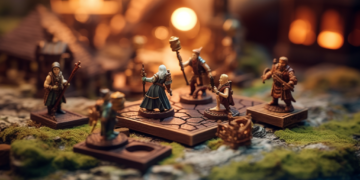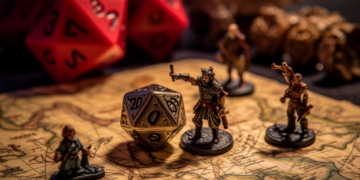
Picture this: you’re in the heat of battle, demons and monsters clawing at the edges of your party. Suddenly, your wizard steps forward, a glint of determination in their eyes. They begin to chant, their voice rising above the din of battle, and from their outstretched hand erupts a sphere of roaring flame. This is no ordinary fireball – it’s a Flaming Sphere, a second-level conjuration spell that can turn the tide of battle in an instant. Its damage potential is immense, and its radiant light is a beacon of hope in the darkest of dungeons.
Unleashing Fire: The Basics of Flaming Sphere
Can you feel the heat? Can you hear the soft roar and crackle of the flames? The Flaming Sphere spell creates a ball of fire that not only serves as a weapon but also as an imposing force on the battlefield. As a five-foot diameter sphere of fire springs into existence, it lights up the surroundings, casting ominous shadows and bathing the battlefield in an eerie, flickering glow. It’s not just about the damage, but also the psychological impact it has on your enemies. Who wouldn’t be afraid of a massive ball of flame rolling towards them?
The Implications of Conjuration
Conjuration, the school of magic that brings forth the Flaming Sphere, is about creating something from nothing. It’s about bending the raw elements of the world to your will and shaping them into something new. The Flaming Sphere is a prime example of this, pulling fire from the ether and forming it into a weapon. But what does this say about the user? What does it mean to conjure something as volatile and dangerous as fire? Is it simply a display of power, or is it a testament to the caster’s control and precision?
The Mechanics of the Flaming Sphere
Now, let’s truly illuminate the mechanics of the Flaming Sphere, our fiery friend in the world of Dungeons & Dragons. This spell, a beacon of conjuration, is more than just a spectacle. It’s an entity of destruction, a tool of tactical warfare, and a manifestation of a wizard’s power.
When cast, the Flaming Sphere creates a 5-foot-diameter ball of fire that springs into existence at a spot within a caster’s line of sight. The sphere emits bright light, transforming the darkest dungeons into a scene of blazing terror.
Damage and Duration
What does it mean to be on the receiving end of a Flaming Sphere? It’s an experience best avoided. The sphere inflicts 2d6 fire damage to creatures that end their turn within 5 feet of it. This damage increases by 1d6 for each slot level above the second. The sphere can maintain its destructive dance for a minute, provided the caster maintains concentration.
Don’t be fooled by its fiery facade. The Flaming Sphere is not a mere pyrotechnics show; it’s a potent weapon in the arsenal of any spell-caster. Like a deadly waltz, it dances around the battlefield, leaving destruction in its wake.
Controlling the Sphere
But what about control? Can you direct this flaming juggernaut? Indeed, you can. As a bonus action, the caster can move the sphere up to 30 feet. If it rams into a creature, that creature must make a saving throw. The sphere stops moving this turn when it hits a creature or a solid barrier.
Imagine the possibilities. You could roll it into a group of unsuspecting enemies, or use it to block a narrow passage. The sphere is more than a weapon; it’s a tactical tool, a fiery chess piece in the grand game of battle.
Strategic Use of the Flaming Sphere
Now, let’s set our minds ablaze with the strategic possibilities of the Flaming Sphere. This spell is not just about dealing damage; it’s about controlling the battlefield, manipulating your foes, and turning the tide of battle.
Suppose you find yourself in a narrow dungeon corridor, facing a horde of goblins. Why not cast Flaming Sphere, rolling it towards the enemy? Watch as chaos ensues. The goblins scatter, breaking their formation, giving your party the upper hand.
Or perhaps you’re in a forest, fighting a band of orcs. Use the sphere to start a fire, creating a barrier between you and your foes. Your enemies must now choose – face your fiery might or brave the blaze.
Remember, in D&D, strategy often wins over raw power. The Flaming Sphere is not just a spell; it’s a testament to a wizard’s tactical acumen. Can you think of other strategic uses for this spell? The battlefield is your canvas, and the Flaming Sphere, your brush. What masterpiece will you create?
Counters and Limitations
As with all spells, the Flaming Sphere is not without its counters and limitations. Despite its power and versatility, it’s crucial to remember that it is not invincible. In the heat of battle, what strategies might your adversaries employ to counteract your fiery weapon?
One major counter is protective spells. Spells such as Protection from Energy can nullify or significantly reduce the damage caused by the Flaming Sphere. Additionally, a well-timed Counterspell can snuff out your sphere before it even forms.
Environmental factors can also put a damper on your Flaming Sphere. A sudden downpour of rain, a body of water, or a magical barrier could extinguish the sphere. The sphere also requires concentration to maintain. This means that any damage to the caster can potentially disrupt the spell.
Comparing the Flaming Sphere to Other Spells
How does the Flaming Sphere stack up against other second-level conjuration spells? What sets this fiery orb apart from its magical counterparts?
| Spell | Type of Damage | Duration | Control |
|---|---|---|---|
| Flaming Sphere | Fire Damage | Up to 1 minute | Controlled Movement |
| Web | No Damage | Up to 1 hour | No Movement |
| Dust Devil | Bludgeoning Damage | Up to 1 minute | Controlled Movement |
| Misty Step | No Damage | Instantaneous | No Control |
As you can see, the Flaming Sphere offers a unique blend of damage, control, and duration. While other spells may last longer or provide different effects, none offer the same combination of controlled movement and persistent fire damage. But as always, the choice of spell depends on the situation at hand and your strategy.
The Flaming Sphere in Narrative Context
Can you imagine the intimidating power of a roaring ball of fire, not just in the heart of combat, but also in enhancing the narrative of your D&D campaign? When employed with a dash of creativity, the Flaming Sphere spell becomes not just a weapon, but a tool for storytelling, a source of light, a tool for intimidation, or even a catalyst for plot points.
Imagine the suspense as your party ventures deeper into a pitch-dark cave, your only source of light the Flaming Sphere dancing ahead. The flickering shadows cast by the sphere add an eerie atmosphere, heightening the tension. Or picture a tense standoff with a group of bandits, the situation escalating when your wizard summons a Flaming Sphere. The sight of the fiery orb, its heat palpable even from a distance, serves as a potent deterrent, possibly avoiding conflict altogether.
But let’s not forget the creative potential of this spell in pushing the plot forward. For instance, the sphere could accidentally ignite a structure, setting off a chain of events that steer the campaign in an unexpected direction. Isn’t that the beauty of D&D, the unpredictability that keeps you on your toes?
Conclusion: The Flame that Keeps on Giving
As we conclude, it’s clear that the Flaming Sphere spell is more than just a second-level conjuration spell. It’s a testament to the versatility and creativity that Dungeons & Dragons encourages in its players. It’s not just about the damage it deals, but the endless possibilities it presents in shaping your adventure.
So, why not embrace the power, the fantastic possibilities that the Flaming Sphere spell offers? Whether you’re in the thick of battle, exploring the darkness, or driving your narrative, this spell is a potent ally. And remember, the only limit here is your imagination.
- Use it as a light source: Illuminate dark areas, reveal hidden enemies, or create an atmospheric setting.
- Employ it as a deterrent: Intimidate foes into backing down without a fight.
- Use it as a diversion: Distract enemies while your party makes a quick getaway.
- Unleash it as a weapon of destruction: Burn down barriers or structures, creating new paths or causing chaos.
- Identify it as a beacon: Mark your location for allies to find or lead enemies into a trap.
- Deploy it as a signal: Use the bright light to send signals or messages over long distances.
- Integrate it into the plot: Make it a key factor in your narrative, triggering events or influencing outcomes.






